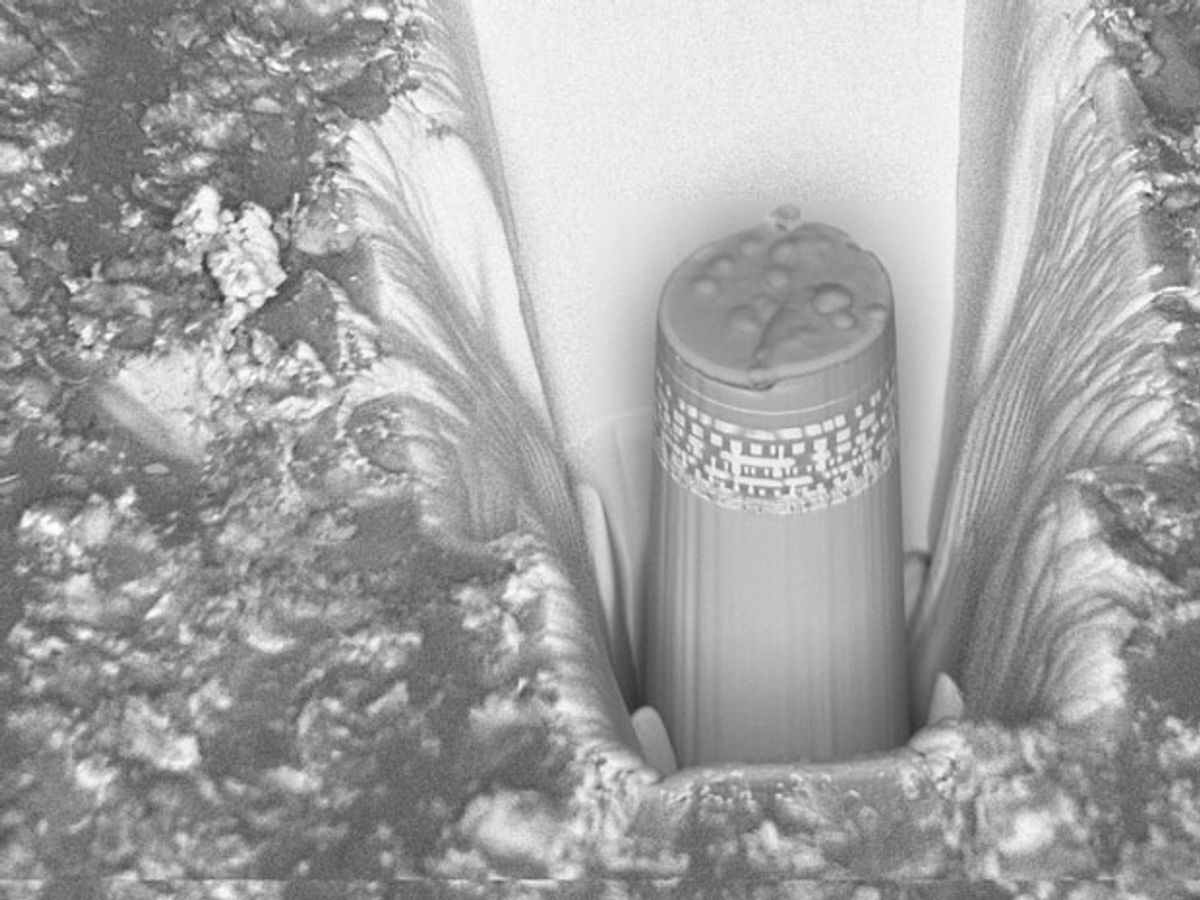A team of researchers based in Switzerland is on the way to laying bare much of the secret technology inside commercial processors. They pointed a beam of X-rays at a piece of an Intel processor and were able to reconstruct the chip’s warren of transistors and wiring in three dimensions. In the future, the team says, this imaging technique could be extended to create high-resolution, large-scale images of the interiors of chips.
The technique is a significant departure from the way the chip industry currently looks inside finished chips to reverse engineer them or check that intellectual property hasn’t been misused. Today, reverse-engineering outfits progressively remove layers of a processor and take electron microscope images of one small patch of the chip at a time.
But “all it takes is a few more years of this kind of work and you’ll pop in your chip and out comes the schematic,” says Anthony Levi, of the University of Southern California. “Total transparency in chip manufacturing is on the horizon. This is going to force a rethink of what computing is,” he says, and what it means for a company to add value in the computing industry.
Even if this approach isn’t widely adopted to tear down competitors’ chips, it could find a use in other applications. One of those is verifying that a chip has only the features it is intended to have, and that a “hardware Trojan”—added circuitry that could be used for malicious purposes—hasn’t been introduced.
The work was conducted at the Paul Scherrer Institute’s Swiss Light Source. The facility is a synchrotron; it accelerates electrons to close to the speed of light in order to generate beams of X-rays.
When the Swiss team shines an X-ray beam through a 22-nanometer-generation Intel processor, the various circuit components—its copper wires and silicon transistors, and other features—scatter the light in different ways and cause constructive and destructive interference. The researchers pointed the beam at their sample from a number of different angles, and using a technique called X-ray ptychography, they could reconstruct a chip’s internal structure from the resulting diffraction patterns.
The resolution for this technique in any one direction is 14.6 nm, which rendered only a fairly blurry image of the individual transistor components. The resolution can be improved, but thanks to Moore’s Law it will be a race to keep up with the chip industry.
This is not the first time that researchers have attempted to use X-rays to image the interior of integrated circuits, says team member Gabriel Aeppli. But “the resolution is better than it’s been in the past. The scale is also larger,” he says. “It’s a huge chunk of the chip compared to what you could do with any other technique.”
The imaging itself was no small feat. The sample has to remain stable, and interferometers must be used to continuously measure its position. It took about 24 hours to perform the X-ray measurements, and the data processing took about as long, says team leader Mirko Holler. But additional computers should easily speed the processing, he says. And improvements to X-ray sources as well as other parts of the experimental apparatus could improve the imaging speed by a factor of 1,000.
“What they’ve done is a proof of concept, and it’s quite impressive at that level,” says Dick James, an emeritus fellow at TechInsights, which strips chips down to the transistor level to examine how the devices are built and wired together.
James says there are practical limitations to the amount of circuitry that can be analyzed using those traditional tear-down techniques, which, depending on the packaging, sometimes start with a bath in sulfuric acid. But he notes that a lot can be gleaned by piecing together small electron microscope pictures of a chip: “You can get most of the cell library by looking at smaller areas.”
Although X-ray ptychography does promise bigger, high-resolution views, it faces several obstacles, James says. For one, chip feature sizes at the cutting edge could prove a challenge for its resolution. “The industry is getting ahead of this technique already,” he says. Another impediment is the need for a synchrotron source. These machines aren’t likely to find their way into chipmaking fabs, although there are a number of such facilities around the world, and it is possible to rent time on them.
Because of these limitations, James says, the best application for this imaging technique could be on chips that are made using older manufacturing processes, and thus have larger features. This is the case for a number of chips used in military and space applications. “If you can look at the whole chip, then you can compare the chip with the original design,” James says, and “do a direct comparison [to] see if there are any obvious faults or any extra circuitry that’s been put in.”
